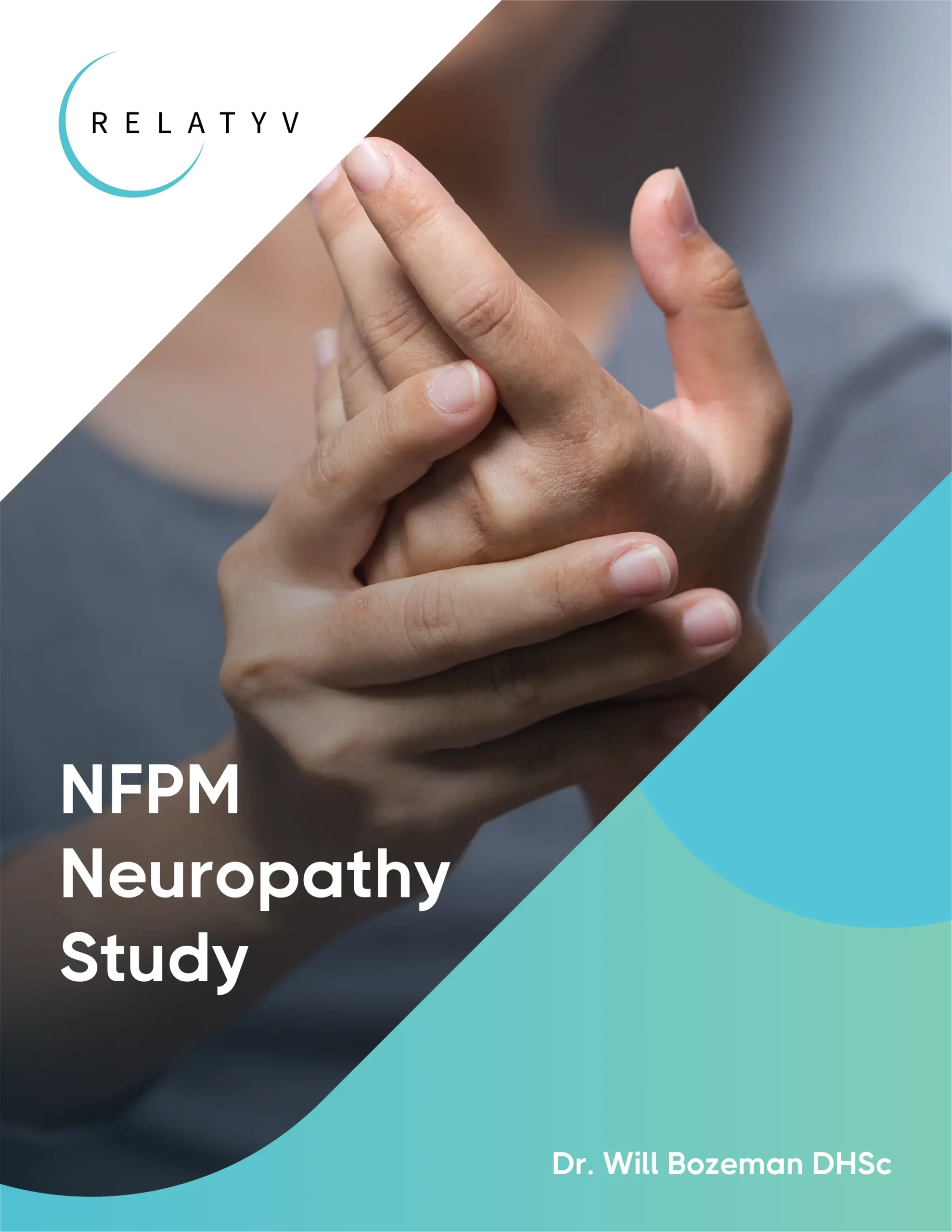Sciatica

Unraveling What Causes Sciatica And Buttock Pain
Read More
July 24, 2023
The pain caused by sciatica can be excruciating, significantly impacting daily life and making even simple tasks challenging. Many people suffering from sciatica wonder how long the pain will last and what they can do to find relief. So, how long does sciatica pain last?
Throughout this article, we will explore the different types of sciatica, the severity of pain associated with each, as well as the expected recovery time from this painful condition. We will also explore conventional treatments that are often recommended for managing sciatica pain.
Additionally, we will introduce the specialized and innovative pain management options that Relatyv offers that can help you find long-term sciatica pain relief.
By the end of this article, you will have a better understanding of sciatica pain, its duration, available treatment options, and how Relatyv can provide a safe and effective approach to managing sciatica and improving your overall quality of life.
Dealing with sciatica can be challenging due to its different forms and levels of pain. By learning the different types of sciatica, you can unlock valuable insights into your condition that may help you find effective treatment.
So, let’s explore the three main types of sciatica and how they can differ in severity.
Acute sciatica refers to a sudden onset of pain caused by compression or irritation of the sciatic nerve. This type of sciatica typically lasts for a relatively short period, with most cases resolving within a few days to a few weeks with proper treatment and self-care.
Chronic sciatica is characterized by persistent or recurrent pain that lasts for an extended period, usually exceeding three months. This type of sciatica is often a result of an underlying condition such as spinal stenosis or herniated discs. Chronic sciatica requires a more comprehensive treatment approach to manage pain and discomfort effectively.
Lumbar sciatic pain refers to pain that specifically originates from the lower back. This condition occurs when the spinal canal of the lower back narrows, causing compression of the nerves, including the sciatic nerve. It can lead to chronic sciatica symptoms and may require specialized interventions to alleviate pain and restore functionality.
Sciatica pain is a highly personal experience and can vary due to individual factors, clinical factors, the type of sciatica, and the underlying health condition. The severity of sciatica pain experienced and how long it may last can vary across these different types.
However, by having an understanding of the standard pain levels that can be experienced within each type of sciatica, you can gain insights relative to your own journey and seek appropriate measures for relief.
While we understand that pain levels are subjective and can vary, we have categorized the pain associated with the three different types of sciatica into three distinct levels: mild, moderate, and severe.
This classification aims to provide a clearer understanding of the varying degrees of pain that individuals may experience.
In some cases, acute sciatica may present as mild discomfort. Individuals may experience occasional twinges of pain or a dull ache in the lower back or buttocks region. The pain may be intermittent and manageable with self-care techniques.
Moderate discomfort often involves more frequent episodes of pain. Individuals may experience a sharp, shooting pain that radiates down the leg, making it challenging to engage in normal daily activities.
Severe discomfort associated with acute sciatica can significantly impact an individual’s quality of life. The pain may be constant and intense, leading to difficulty walking, standing, or sitting. Prompt medical attention is crucial to address severe pain and prevent further complications.
Mild discomfort in chronic sciatica may involve persistent low-level pain. Individuals can experience a nagging ache or dull sensation in the lower back, buttocks, or legs. The pain may be tolerable and manageable with self-care measures or non-invasive treatment options.
Moderate discomfort indicates a more pronounced level of pain. Individuals can experience sharp, shooting pain that radiates along the sciatic nerve pathway, extending down into the hip and thigh. The pain may come and go, affecting daily activities and overall well-being. In moderate cases, a combination of conservative treatments and personalized care is often necessary.
Severe discomfort in chronic sciatica can be highly debilitating. Individuals can endure intense, constant pain that hampers mobility and impairs daily functioning. This level of pain often requires a multidisciplinary approach involving specifically tailored interventions
Mild discomfort in lumbar spinal stenosis-related sciatica may present as a subtle ache or tingling sensation in the lower back or legs. The pain may be sporadic and manageable with self-care techniques such as stretching, physical therapy, and pain medications.
Moderate discomfort in lumbar spinal stenosis involves more persistent pain. Individuals may experience a sharp, shooting pain that radiates down one leg, causing difficulty in walking or standing for extended periods. Comprehensive treatment strategies tailored to the underlying condition may be necessary.
Severe discomfort in lumbar spinal stenosis-induced sciatica can significantly impact an individual’s daily life. The pain may be excruciating and constant, leading to limitations in mobility and reduced quality of life. An appropriate diagnosis with specialized medical intervention and tailored treatments are essential to managing severe pain effectively.
Sciatica pain is inherently nerve pain as it stems from the compression or irritation of the sciatic nerve. But how long does sciatica nerve pain last?
Acute sciatica pain typically lasts a few weeks to a few months, gradually improving with proper care. On the other hand, chronic sciatica involves long-term pain lasting beyond three months. This may vary for each individual; Some may experience intermittent episodes of pain over an extended period, and others may have persistent pain that requires ongoing management and treatment.
The duration of pain in lumbar spinal stenosis-induced sciatica can also vary, with mild cases being intermittent and manageable. While moderate to severe cases may require more comprehensive and specialized treatment, which can impact the duration of pain.
It is clear that factors such as the underlying health condition and treatment effectiveness influence the duration of sciatic nerve pain. Additionally, seeking timely medical attention, following a personalized treatment plan, and practicing appropriate self-care measures aid in faster recovery and effective pain relief.
Next, let’s go on to talk about some of the conventional treatments for sciatica
If you or someone you know is suffering from this painful condition, you would know that finding effective long-term relief is a top priority. There are various treatment options available for the painful symptoms of sciatica, ranging from conservative measures to more invasive interventions.
When seeking effective relief, it is essential to be prepared and informed about the pros and cons of each approach. Some of the most commonly prescribed conventional treatments include:
Applying a heat compress or cold pack to the affected area can help reduce inflammation and alleviate pain. Heat therapy improves blood circulation, while cold therapy helps numb the area and reduce swelling. Heat and cold therapy is likely to only provide short-term alleviation and may not be deeply effective for moderate to severe cases of sciatica pain.
Over-the-counter pain relievers, such as nonsteroidal anti-inflammatory drugs (NSAIDs), can help alleviate mild to moderate sciatica pain. In more severe cases, pharmaceuticals such as opioids or muscle relaxants may be prescribed to manage pain and inflammation. Pharmaceuticals offer temporary relief and may not suffice for moderate to severe sciatica pain.
Additionally, due to concerns about the dependency-inducing nature of these medications, many people are cautious about using them for an extended period.
Physical therapy exercises and stretches can help improve flexibility, strengthen the muscles, and relieve pressure on the sciatic nerve. A qualified physical therapist can develop a personalized program tailored to an individual’s needs. It is important to see a professional, as over-manipulation may worsen sciatica symptoms.
Using assistive devices, such as a supportive back brace or crutches, can help reduce pressure on the spine area and provide temporary relief. These devices can also assist in maintaining and training proper posture and spinal support.
In some cases, corticosteroid injections may be recommended to reduce inflammation and provide temporary pain relief. These injections are administered directly into the affected area under the guidance of a healthcare professional. It’s important to note that long-term, repetitive use of steroids may cause joint and bone deterioration.
Common surgical treatments for sciatica pain include discectomy (disc removal) and spinal fusion to stabilize the spine. These can provide significant relief and help resolve underlying issues, especially in severe cases. However, there are significant risks from an invasive surgical procedure, such as infection, bleeding, and potential complications. Recovery time can be lengthy, and success rates vary depending on individual factors.
While conventional treatments for sciatica pain may not provide long-term relief for everyone, Relatyv offers innovative, non-pharmaceutical alternatives for lasting pain management. Let’s explore how Relatyv can help you find the relief you seek from sciatica pain.
At Relatyv, we understand the impact sciatica pain can have on your daily life. Our dedicated team offers effective treatment options which prioritize long-lasting relief without relying on pharmaceuticals or invasive surgeries.
Our approach integrates Neurofunctional Pain Management (NFPM) concepts into our Relatyv protocol, addressing the root causes of sciatica pain while considering overall well-being. Additionally, we conduct thorough diagnostics, which allow us to tailor treatment plans to each patient’s needs and goals.
We utilize non-invasive Electroanalgesia, a therapy involving high-pulse electrical stimulation. By interrupting pain signals and promoting cellular-level pain relief, Electroanalgesia provides long-term relief without medications.
Our specialized hydration intravenous therapy (IV therapy) addresses individual nutritional deficiencies and restores essential nutrients and electrolytes. IV therapy reduces inflammation, optimizing organ function and significantly alleviating sciatica symptoms.
We provide lifestyle counseling and education programs to address the psychological impact of painful symptoms. Our initiatives empower patients to maintain strong psychological health, adopt helpful strategies, and achieve long-term pain relief.
At Relatyv , we understand the importance of addressing sciatica pain effectively. Our priority is to provide safe, effective, and personalized treatment options. This is crucial because if sciatica pain is left untreated, it can lead to serious complications, which we will discuss in the next section.
Leaving sciatica untreated can lead to potential complications and worsen the symptoms over time. Some possible complications include:
Untreated sciatica can significantly limit your ability to perform daily activities. The pain and discomfort may hinder mobility, making it challenging to carry out simple tasks or participate in physical activities.
Living with chronic pain can take a toll on your mental health. Untreated sciatica may contribute to increased stress levels, anxiety, and even depression. Seeking appropriate treatment can help alleviate pain and improve overall well-being.
Prolonged compression or irritation of the sciatic nerve can result in nerve damage. This can lead to long-term neurological complications, including sensory loss, muscle weakness, or even paralysis in severe cases.
Untreated sciatica can potentially contribute to the development of chronic pain syndromes. These conditions may cause persistent pain even after the initial cause of the sciatica has been addressed. Early intervention is crucial to prevent the progression of chronic pain.
When it comes to sciatica pain, proper treatment is essential for managing the underlying condition. However, there are several self-care measures and lifestyle adjustments that can complement medical interventions. Here are some tips for coping with sciatica:
Maintaining good posture will alleviate the pressure placed on the sciatic nerve, whether sitting, standing, or walking. Additionally, engaging in regular exercise, such as low-impact activities like swimming or walking, can help strengthen muscles and improve flexibility.
Alongside exercise, maintaining a balanced and nutritious diet is important. Including anti-inflammatory foods like fruits, vegetables, whole grains, and healthy fats can help reduce inflammation and alleviate pain.
Staying hydrated and avoiding processed foods and sugary beverages further support overall health and contribute to pain management.
Struggling with the pain of sciatica can be stressful. Incorporating relaxation techniques like meditation or deep-breathing exercises into the daily routine can help manage stress levels and promote a sense of calm.
Taking time for oneself, engaging in activities that bring joy and relaxation, and practicing mindfulness can also be beneficial. Additionally, seeking support from loved ones or joining support groups can provide a sense of understanding and connection.
Prioritizing self-care, exercise, nutrition, and stress management strategies can contribute to a better emotional state while managing sciatica pain.
Sciatica pain can have a powerful impact on your quality of life. Understanding the different types of sciatica, associated pain levels, and available treatment options can help you seek effective pain management.
While conventional treatments can provide relief for many, the alternative approaches offered by Relatyv provide innovative solutions for long-term sciatica pain management. By utilizing a Neurofunctional Pain Management (NFPM) approach and our tailored protocols, we offer personalized treatment options that go beyond traditional methods.
At Relatyv, our dedicated team of professionals is committed to safe, personalized care, addressing the root causes of your pain, and helping you regain control of your well-being. We are here to support you on your journey toward long-lasting relief from sciatica pain.
About the Author
Will is a healthcare executive, innovator, entrepreneur, inventor, and writer with a wide range of experience in the medical field. Will has multiple degrees in a wide range of subjects that give depth to his capability as an entrepreneur and capacity to operate as an innovative healthcare executive.
Share on Social Media




You can see how this popup was set up in our step-by-step guide: https://wppopupmaker.com/guides/auto-opening-announcement-popups/
You can see how this popup was set up in our step-by-step guide: https://wppopupmaker.com/guides/auto-opening-announcement-popups/
Neurofunctional Pain Management Overview
IV Therapy
Symptoms
Conditions Treated
Treatments
Articles by Category
Locations
Colorado
Wisconsin
Georgia
Hiram
Lawrenceville
Marietta
Powder Springs
Texas
Waco
Victoria
Illinois
Buffalo Grove
New Lenox
St. Charles
Arizona
Tucson
Waddell
Arlington
Avondale
Buckeye
Superior
Mesa
Palo Verde
Morristown
Tempe
Chandler
Anthem
Eloy
Florence
Fort McDowell
Phoenix
El Mirage
Coolidge
Gilbert
Arizona City
Casa Grande
Casa Blanca
Aguila
Sacaton
Apache Junction
Kearny
Stanfield
Goodyear
Litchfield Park
Alabama
Arkansas
California
Florida
Idaho
Michigan
Rhode Island
Minnesota
New Mexico
North Carolina
Ohio
Pennsylvania
South Dakota
Tennessee
Virginia

